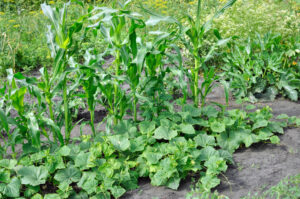Companion Planting

Companion planting is an age-old agricultural practice that involves planting different crops in proximity based on their ability to enhance one another’s growth and protect each other from pests. This symbiotic relationship is a prime example of natural ecosystem management, beneficial for both the plants and the environment.
Brief History and Traditional Use
The history of companion planting is as old as agriculture itself, with roots in various ancient cultures around the world. Native American agricultural communities, for instance, famously employed the “Three Sisters” method—planting corn, beans, and squash together. Each plant contributed uniquely to the health and growth of the others.
Discovery of Companion Plants
The discovery of companion plants has mostly been a result of observational learning over generations. Farmers noticed that certain plants thrived when grown together and suffered when grown in isolation. These observations, coupled with trial and error, led to the identification of beneficial plant pairings, laying the foundation for what we know today as companion planting.
Benefits of Companion Planting
Companion planting offers a multitude of benefits that contribute to a sustainable and productive agricultural system. Here are a few key benefits:
Pest control
Many companion plants serve as natural pest deterrents. They emit certain scents or chemicals that repel harmful pests, eliminating the need for synthetic pesticides. For instance, marigolds planted among tomatoes can deter nematodes.
Boost crop yield
In companion planting, the plants support each other’s growth, leading to increased yield. For example, beans fix nitrogen in the soil, providing necessary nutrients for corn, and thereby boosting its yield.
Soil improvement
Companion plants often contribute to soil health. Certain plants, like legumes, fix nitrogen into the soil, enriching it and making it more fertile and conducive for other plants.
Biodiversity
Companion planting promotes biodiversity by encouraging a variety of plants to grow in the same area. This diversity not only makes for a healthier ecosystem but also reduces the risk of disease and pest infestations that can occur in mono-cropping systems.
How to Implement Companion Planting in a Home Garden
The concept of companion planting can be implemented in home gardens as well, offering the same benefits as it does in large-scale agricultural systems. Here are some strategies to consider:
Planning and Layout
Planning is a crucial step in companion planting. Start by sketching a layout of your garden, taking into account the size, sunlight exposure, and water availability. This can help you visualize where each plant pair will go and make the most of your space.
Choosing the Right Plant Pairs
Not all plants make good companions. Some plants may compete for the same resources, while others may attract pests. Thus, it’s crucial to choose the right plant pairs. Research about plant compatibility or refer to a companion planting guide to make informed decisions.
Tips and Best Practices
Here are some tips for successful companion planting:
- Rotate crops every growing season to prevent depleting the soil of certain nutrients.
- Practice diversity by planting a variety of species to promote a balanced ecosystem.
- Observe your garden closely and take notes. You can learn a lot about plant relationships through your observations.
- Be patient. It may take a few seasons to see the full benefits of companion planting.
Organic Gardening and Companion Planting
Embracing companion planting is a cornerstone of successful organic gardening. Organic gardening is all about cultivating plants naturally, without the use of synthetic pesticides or fertilizers. Companion planting complements this approach significantly. It encourages biodiversity, which naturally deters pests and promotes a robust and healthy ecosystem. Moreover, certain plant pairings can improve soil fertility. For instance, legumes fix nitrogen in the soil, thereby benefiting nitrogen-loving plants planted nearby. Through these synergistic relationships, companion planting reduces the need for artificial inputs, making your garden not only more sustainable but also more in tune with nature’s rhythms.
Popular Companion Planting Guilds
Understanding popular companion planting guilds can guide gardeners towards more efficient and productive gardens.
Three Sisters
One of the most famous guilds is the “Three Sisters” consisting of corn, beans, and squash. The corn provides a natural structure for the beans to climb, eliminating the need for poles. The beans, being legumes, help enrich the soil with nitrogen, benefiting the corn. The squash spreads along the ground, blocking the sunlight and thereby preventing the establishment of weeds. The spikes of the squash leaves also deter pests.
Tomato, Basil, and Marigold
Another popular guild is the “Tomato, Basil, and Marigold” guild. Basil is known to repel harmful insects that can damage tomatoes, and marigolds are often used as a deterrent for nematodes. These guilds exemplify the principles of companion planting, demonstrating how diverse plants can benefit each other when grown together.
Cucumbers and Nasturtiums, Cabbages and Dill
Just as with the aforementioned guilds, cucumbers and nasturtiums, as well as cabbages and dill, form advantageous gardening partnerships. Nasturtiums, with their vibrant flowers, don’t just add aesthetic appeal to your garden; they also serve a significant role as a companion to cucumbers. Nasturtiums are exceptionally good at repelling cucumber beetles and other pests, protecting the cucumbers and helping them to grow undisturbed.
In a similar vein, cabbages and dill make a beneficial pairing. Dill attracts a variety of beneficial insects that control pests such as aphids and cabbage loopers. In addition, the strong scent of dill can confuse pests, making it harder for them to find their target plants. This way, your cabbages remain well-protected and can grow to their full potential. Pairing these plants together harnesses their natural abilities and encourages a productive and vibrant garden environment.
Potatoes and Pole Beans
Similarly, potatoes and pole beans, alongside nasturtiums, form another functional guild. The pole beans climb and provide cover, reducing the presence of weeds around the potatoes. Meanwhile, the nasturtiums repel beetles and other pests, proving to be an effective natural pesticide.
Apple Tree Guilds
In the realm of fruit trees, apple trees form successful partnerships with chives, garlic, and onions. The strong aroma of these plants deters many pests that could harm apple trees. Additionally, their small stature and low maintenance make them ideal companions for apple trees, as they do not compete for resources. This guild illustrates the principle of companion planting, a testament to the effectiveness of biodiversity in enhancing productivity and sustainability in gardening.
Challenges in Companion Planting
While the concept of companion planting offers numerous benefits, it is not without its challenges. A primary issue pertains to space considerations.
In a small garden, ensuring each plant has the necessary room to grow while still maintaining close proximity for mutual benefit can be a delicate balancing act. Overcrowding can cause competition for resources, resulting in stunted growth or plant stress.
One potential solution is vertical gardening. This technique involves growing plants upwards instead of outwards, utilizing trellises, cages, or stakes. Vertical gardening can maximize space, allowing for efficient use of the available area.
Careful Garden Planning
Another strategy involves careful garden planning. Gardeners can sketch out their garden space, factoring in the mature size of each plant to ensure enough room for growth. Remember, the goal is to create a beneficial ecosystem where all plants thrive, so thoughtful planning and creative strategies are key.
Timing and Growth Rates
Another crucial aspect to consider in companion planting is timing and growth rates. Plants in a guild should ideally be planted at the same time to ensure they grow at a similar rate. If one plant matures significantly faster, it might overshadow others, causing competition for sunlight and nutrients. Therefore, understanding the growth habits and rates of your chosen plants is critical for successful companion planting.
Pest Management
Pest management is another challenge in companion planting. While some plants repel certain pests, they might attract others. Therefore, a comprehensive understanding of each plant’s pest attraction and repulsion properties is required. For instance, while marigolds are known to repel nematodes, they are also known to attract spider mites. Thus, effective pest management involves a combination of strategic planting and regular monitoring to swiftly address any pest issues that may arise. By observing these principles, gardeners can harness the full potential of companion planting, creating a diverse, vibrant, and productive garden ecosystem.
Conclusion
The future of companion planting is promising, with ongoing research and advancements demonstrating its potential for sustainable agriculture. Innovative techniques, new plant combinations, and a growing understanding of plant relationships are all contributing to the evolution of this horticultural practice. Current studies are focusing on the scientific validation of age-old wisdom, unraveling the intricate dynamics of plant interactions in a bid to optimize crop production and resilience.
Moreover, the long-term benefits of companion planting for sustainable agriculture are multifold. By promoting biodiversity, reducing dependency on artificial fertilizers and pesticides, and enhancing soil health, companion planting supports an environmentally friendly farming approach. It also fosters resilience in the face of climate change, a critical consideration in the modern age. The practice of companion planting, thus, holds the potential to shape a more sustainable and resilient future for global agriculture.
For more gardening topics click here.
For information on permaculture which uses companion planting click here.

